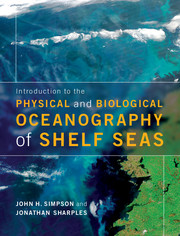Book contents
- Frontmatter
- Contents
- Preface
- Acknowledgements
- Guide to the book and how to make the best use of it
- Symbols
- 1 Introduction to the shelf seas
- 2 Physical forcing of the shelf seas: what drives the motion of ocean?
- 3 Response to forcing: the governing equations and some basic solutions
- 4 Waves, turbulent motions and mixing
- 5 Life in the shelf seas
- 6 Seasonal stratification and the spring bloom
- 7 Interior mixing and phytoplankton survival in stratified environments
- 8 Tidal mixing fronts: their location, dynamics and biological significance
- 9 Regions of freshwater influence (ROFIs)
- 10 The shelf edge system
- 11 Future challenges in shelf seas
- Glossary
- Answers to chapter problems
- References
- Index
- Plate section
- References
1 - Introduction to the shelf seas
Published online by Cambridge University Press: 05 June 2012
- Frontmatter
- Contents
- Preface
- Acknowledgements
- Guide to the book and how to make the best use of it
- Symbols
- 1 Introduction to the shelf seas
- 2 Physical forcing of the shelf seas: what drives the motion of ocean?
- 3 Response to forcing: the governing equations and some basic solutions
- 4 Waves, turbulent motions and mixing
- 5 Life in the shelf seas
- 6 Seasonal stratification and the spring bloom
- 7 Interior mixing and phytoplankton survival in stratified environments
- 8 Tidal mixing fronts: their location, dynamics and biological significance
- 9 Regions of freshwater influence (ROFIs)
- 10 The shelf edge system
- 11 Future challenges in shelf seas
- Glossary
- Answers to chapter problems
- References
- Index
- Plate section
- References
Summary
In this chapter we shall introduce the reader to the shelf seas, their extent and position in the global ocean and the motivation, both fundamental and applied, behind our efforts to understand and model the complex processes which control the shelf sea environment and ecosystem. We shall then briefly explain the historical development of shelf sea science and describe the technical tools which are now available and which have facilitated the relatively rapid advances of recent years. As well as discussing the principal observational techniques, in a final section we shall consider the role of numerical modelling and its potential contribution to developing understanding.
Definition and relation to the global ocean
Between the deep oceans and the continents lie the seas of the continental shelf. These shallow areas usually have rather flat seafloors and extend out to the shelf break, where the seabed inclination generally increases rapidly at the top of the continental slope leading down to the abyssal ocean. This abrupt change of slope is clear in the map of global bathymetry shown in Fig. 1.1a. It typically occurs at a depth of ~200 metres and a contour, or isobath, at this depth is often taken as defining the outer limit of the shelf seas. This choice is not critical, however, since the continental slope is so steep (~1:10); moving from the 200- to the 500-metre isobath involves little horizontal movement. Using the basis of a 500-metre definition, Fig. 1.2a shows that the shelf seas account for ~9% of the total area of the global ocean and less than 0.5% of the volume. The shelf seas have an influence and importance quite out of proportion to these numbers.
- Type
- Chapter
- Information
- Publisher: Cambridge University PressPrint publication year: 2012
References
- 1
- Cited by



